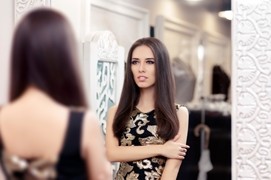 “Mirror, mirror on the wall. This lighting doesn’t work for me at all.”
“Mirror, mirror on the wall. This lighting doesn’t work for me at all.”
My amusing poem is a fitting way to describe how shoppers are using “smart mirrors” to enhance their experiences.
Where have you been all of my life?
Let’s take a look at how the technology, which can be found in dressing rooms at places such as Ralph Lauren’s flagship store, works:
Equipped with radio-frequency identification technology that tracks items via their tags, the room identifies every item that enters and reflects it back on the mirror that doubles as a touchscreen. Shoppers can interact with the mirror, which functions like a giant tablet, to control the lighting, request alternate items or style advice from a sales associate.
“There’s this narrative that ecommerce collects better data – but online, it’s black and white. The physical world contains all these shades of grey that are truly interesting,” says Healey Cypher, who has built his career around twin concepts, namely that brick-and-mortar shopping isn’t going anywhere and the experience is in desperate need of a technological upgrade.
He’s working on it. Cypher is the CEO and co-founder of Oak Labs Interactive, the company behind the interactive mirrors, which just announced it has raised $4.1 million in a seed round led by Wing Venture Capital to bring refine the technology and bring it to more retailers. …
For retailers, the key draw is the wealth of collected data. By tracking each item that enters a dressing room, Ralph Lauren can determine how shoppers are interacting with its clothes. Is a jacket frequently being tried on, but isn’t selling? This likely indicates the look is popular, but the fit isn’t. Equally valuable: how customers interact with the touchscreen. Are they buying recommended items? How are they interacting with sales associates? Oak Labs analyzes the data and distills it into digestible and actionable insights.
This idea isn’t a new one – Nordstrom has experimented with interactive mirrors in its fitting rooms, and designer Rebecca Minkoff’s flagship store in New York City has employed nearly identical technology for about a year, to huge results. Since its installation, the store reportedly tripled its clothing sales.
Read the full Entrepreneur story.

 Ralph Lauren is worth $7.7 billion. Oprah Winfrey’s empire has skyrocketed to $2.9 billion. They are among the mega-rich and regarded as celebrity royalty.
Ralph Lauren is worth $7.7 billion. Oprah Winfrey’s empire has skyrocketed to $2.9 billion. They are among the mega-rich and regarded as celebrity royalty.